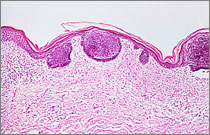Laryngeal cancer
| 2020 | ||
|---|---|---|
¹ per 100,000 persons, age-standardised according to the old European standard population * calculated using the period method for 2019 / 2020 | ||
| Women | Men | |
| Incidence | 510 | 2,690 |
| Age-standardised incidence rate¹ | 0,8 | 4,3 |
| Deaths | 198 | 1,070 |
| Age-standardised mortality rate¹ | 0.2 | 1.6 |
| 5-year prevalence | 2,000 | 10,400 |
| 10-year prevalence | 3,400 | 17,300 |
| Relative 5-year survival rate* | 65 % | 64 % |
| Relative 10-year survival rate* | 51 % | 51 % |
Cancers of the larynx are almost exclusively squamous cell carcinomas. Men are diagnosed with this cancer considerably more frequently than women: Of the approximately 3.200 new cases in 2020, only about one in six affected women. In the course of a lifetime, one in 200 men, but only one in 1,000 women in Germany will develop laryngeal cancer. The average age at which this cancer develops is 67 for women for men, which is earlier than the average age for cancer in general. The age-specific incidence rates for peak between the ages of 65 and 75 years.
Incidence and death rates for men have been declining since the end of the 1990s. The rates for women, on the other hand, have remained virtually unchanged.

![]() Age-standardised incidence and mortality rates by sex, ICD-10 C32, Germany 1999 – 2016/2017, projection (incidence) through 2020, per 100,000 (old European standard population)
Age-standardised incidence and mortality rates by sex, ICD-10 C32, Germany 1999 – 2016/2017, projection (incidence) through 2020, per 100,000 (old European standard population)
The relative 5-year survival rates for men (64 percent) and women (65 percent) do not differ substantially. At 55 percent, men have a higher proportion of early tumour stages (stage I/II) at diagnosis than women (49 percent).
Tobacco and alcohol are the most important risk factors
Regular smoking and also excessive alcohol consumption are the main risk factors for the development of laryngeal cancer. The combination of both factors is particularly harmful.
Links between these tumours and occupational exposure to asbestos, ionising radiation such as uranium, sulphuric acid aerosols, polycyclic aromatic hydrocarbons and coal and tar products are also well established. Cement and wood dust appear to be less relevant.
Infections with human papillomaviruses (HPV), especially HPV 16, are responsible for the development of a small proportion of laryngeal carcinomas.
The influence of lifestyle and diet is not yet clearly understood, since tobacco and alcohol consumption overshadow the influence of other factors in the majority of those affected. However, there are indications that an unbalanced, low-vitamin diet with excessive consumption of meat and fried food might increase risk.
A genetic predisposition is also assumed, since increased incidence of laryngeal cancer has been observed within some families.
Date: 21.03.2024






